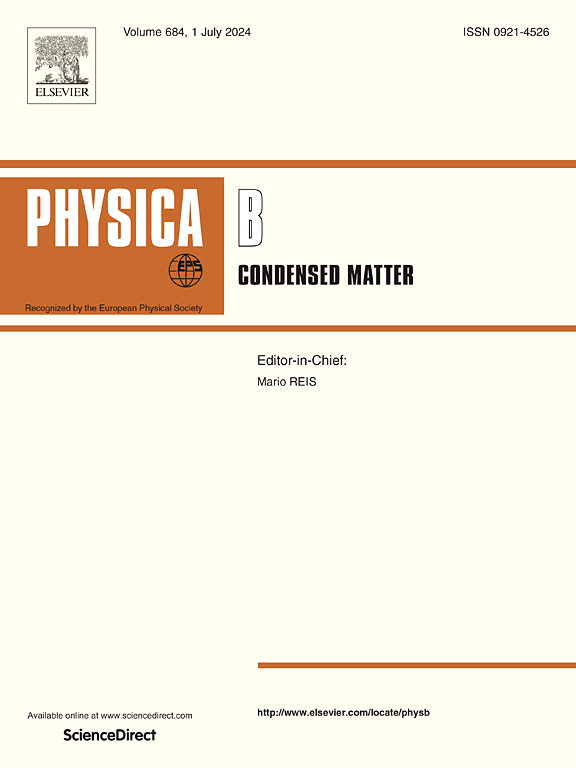Effect of non-metal doping on thermodynamics of dehydrogenation in MgH2
IF 2.8
3区 物理与天体物理
Q2 PHYSICS, CONDENSED MATTER
引用次数: 0
Abstract
MgH is a potential hydrogen storage material for future applications due to its high abundance, gravimetric and volumetric hydrogen storage density compared to other alternatives of metal hydrides. However, high desorption temperature is a major challenge that hinders its application. The present study investigates the effect of site-selective non-metal doping (2p-series: B, C, N, O, and F, and 3p-series: Si, P, S, and Cl) on formation enthalpy and structural stability of doped-MgH using density functional theory (DFT) based calculations. Screening factors such as desorption temperature, bulk modulus, and gravimetric density are considered for screening the dopant atoms, lowering the desorption temperature. Our screening finds doping B, C, N, Si, P, and S reduces the desorption temperature while preserving similar gravimetric density and Bulk modulus as of pristine MgH. Contrarily, doping of F, Cl, and O increases the desorption temperature. The C is the most composition-sensitive dopant among all. However, in B, C, Si, P doping, the change in bulk modulus is minimum ( 5%) compared to the pristine MgH. Moreover, these dopants have the highest impact on the desorption temperature, making them the most preferable dopants among the list. A strong negative correlation between the electronegativity of dopants and the formation enthalpy is found for interstitial/H-substitutional doping sites. A detailed electronic structure analysis points out that the non-metal doping at interstitial/H-substitutional sites destabilizes the Mg–H bonds are suitable candidates to reduce the desorption temperature.
非金属掺杂对MgH2脱氢热力学的影响
与其他金属氢化物替代品相比,MgH2具有高丰度、重量和体积储氢密度,是未来应用的潜在储氢材料。然而,高解吸温度是阻碍其应用的主要挑战。本研究利用密度泛函理论(DFT)计算研究了位置选择性非金属掺杂(2p系列:B、C、N、O和F,以及3p系列:Si、P、S和Cl)对掺杂mgh2形成焓和结构稳定性的影响。考虑了脱附温度、体积模量和重量密度等筛选因素,筛选掺杂原子,降低脱附温度。我们的筛选发现,掺杂B、C、N、Si、P和S降低了解吸温度,同时保持了与原始MgH2相似的重量密度和体积模量。相反,F、Cl和O的掺杂提高了解吸温度。其中C是对成分最敏感的掺杂剂。然而,在B, C, Si, P掺杂下,与原始MgH2相比,体积模量的变化最小(< 5%)。此外,这些掺杂剂对解吸温度的影响最大,是列表中最理想的掺杂剂。在间隙/ h取代掺杂位点上,掺杂剂的电负性与形成焓之间存在很强的负相关关系。详细的电子结构分析指出,在间隙/ h取代位点掺杂非金属使Mg-H键不稳定是降低脱附温度的合适选择。
本文章由计算机程序翻译,如有差异,请以英文原文为准。
求助全文
约1分钟内获得全文
求助全文
来源期刊

Physica B-condensed Matter
物理-物理:凝聚态物理
CiteScore
4.90
自引率
7.10%
发文量
703
审稿时长
44 days
期刊介绍:
Physica B: Condensed Matter comprises all condensed matter and material physics that involve theoretical, computational and experimental work.
Papers should contain further developments and a proper discussion on the physics of experimental or theoretical results in one of the following areas:
-Magnetism
-Materials physics
-Nanostructures and nanomaterials
-Optics and optical materials
-Quantum materials
-Semiconductors
-Strongly correlated systems
-Superconductivity
-Surfaces and interfaces
 求助内容:
求助内容: 应助结果提醒方式:
应助结果提醒方式:


